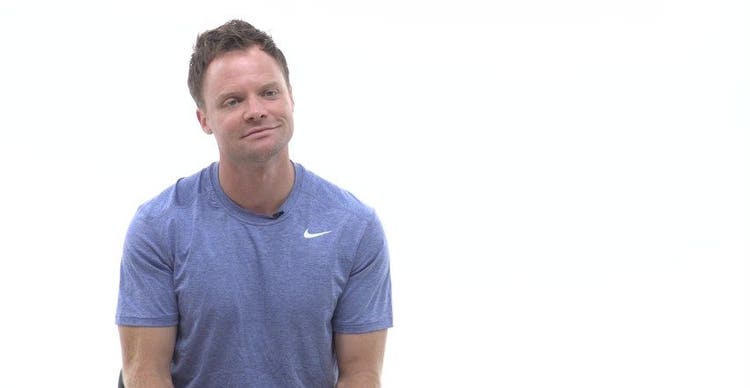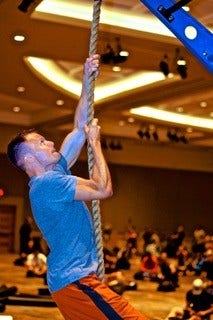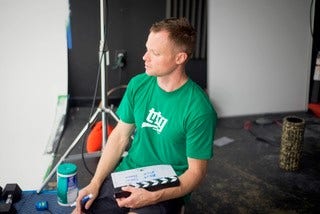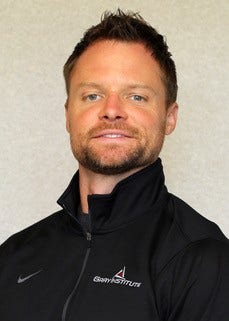Vitality Coach Logan Schwartz Says Health Is The Key to Happiness—Here’s Why

As a parent and fitness and health expert, Logan Schwartz says his first priority for his kids is for them to be healthy. Anything else, including happiness, is secondary to that.
Schwartz, who spent almost a decade as a Division I strength and conditioning coach for the University of Texas men’s and women’s basketball program, believes that health is not merely the absence of disease but the gateway to enjoying life.
“Health is a state of optimal well-being,” he says. “I look at it as vitality. Vitality is where you’re optimally in a state of having energy, and movement is an expression of that energy. Movement is a requirement of life, but it’s also a way that we experience and enjoy life, so the healthier you are, the more energy you have, the more movement you can experience. The more movement you can experience, the better you live. So it’s a cycle. That’s what happiness is to me; it’s not just health for a superficial reason. It’s health so I can actually enjoy more, and I’ve learned that movement is the gateway to that.”
Experience life through movement
As a kid, Schwartz remembers being particularly interested in movement and incredibly active. When Schwartz would get rambunctious, his mom, a fifth-grade teacher, would advise his teachers to let him run a lap around the school, then come back and sit down.
“I’d accumulate 3 miles a day doing that,” Schwartz says, laughing.
At his small school, Schwartz played many sports and practiced martial arts, saying he wasn’t interested in the competition but the ability to express himself during the game.
“From an early age, I knew that you had this physical body, and you experience life with it through movement,” he says. “The times I was really enjoying myself, the times I was happy, were the times I spent with friends playing pickup basketball, or lifting weights in high school, or playing flag football.”
This lifelong love of movement led him to study kinesiology, then on to grad school for exercise physiology. But after a decade of coaching athletes and performance-based movement, Schwartz says burnout caused him to step away and instead focus on helping the general population get healthy for the long term.
“Fitness and health is a long-game approach,” he says. “I say I train people how their 80-year-old self would want me to train them. So what does your 80-year-old self want to do? That’s what we’re going to do.”
Today, Schwartz works on content and programing for 24GO, the free mobile coaching app from 24 Hour Fitness—and he’s particularly passionate about working with the talent and trainers demoing the movements for the app.
Below, Schwartz shares his thoughts on movement versus exercise, finding enjoyment in movement and using our natural environment to our advantage to live happy, healthy and functional lives.
Make movement your foundation

Schwartz defines “exercise” as focused movement—a specific type of movement to meet a specific goal. But movement is the foundation on which exercise is built, and exercise should work to improve that foundation.
He compares it to eating a whole-foods diet and supplementing.
“Movement is the whole-foods natural diet, and exercise is the supplements,” he explains. “So we know that you can’t just take vitamin C supplements and be healthy. You actually have to eat fruits and vegetables. So movement is like your non-processed whole-foods diet, and exercise is the specific supplements you’re lacking. Maybe I’m lacking a little bit of mobility, so I’m going to apply that to my dedicated movement time, or maybe I’m lacking a little bit of strength, so I’m going to supplement with some strength movements.”
Enjoy the journey
For those new to fitness or just getting started on their fitness journey, Schwartz advises looking at movement as the means, not the end.
Oftentimes, he explains, beginners set a goal and aren’t satisfied until they’ve reached that goal. “That’s just not sustainable. You have to enjoy the actual process.”
Schwartz advises finding an activity you enjoy or like in order to make the process sustainable. “It might not be enjoyable in the moment, but the aftereffect, you really enjoy,” he explains. “You have to find satisfaction in today and then what you’re going to do tomorrow.”
He sees this the most with clients who get on plans and then “fall off the wagon.”
“They find the newest plan, and then they fall off the wagon, and then they find the newest one,” he says. “They’re looking for the golden ticket, and—I’ve been doing this a long time—the golden ticket just doesn’t exist.”
Variability is key

Talking to an older generation, Schwartz says that the common thread he’s heard is variability in movement.
“I’ve talked to a lot of 70-, 80-year-old men, and they never say, ‘I found the perfect exercise program, and I just did it every day for 80 years,’” he says. “They always say something like, ‘Well, I did yoga for a while, and then I did triathlons for a couple of years. I got out of that, and now I play some golf, and I got into tennis.’ They really find joy in getting into something new, and when they’re done with that, they move on to another activity—but they’re always active. Again, it’s finding joy and satisfaction in the every day.”
Utilize your environment
At his home in Austin, Texas, you may see Schwartz up at dawn soaking in the sun during his daily morning walk.
“I walk every morning right at sunrise with my dog, completely barefoot, no shirt for about 45 minutes, to get morning sunlight,” Schwartz says.
For Schwartz, one of the downfalls of modern society is our infringement on the necessity of nature and its rhythms.
“We can have sun or light all day. We can have stimulation for our mind at night. We can have a nice, temperature-controlled environment,” he says. “So now I’ve really gotten into environmental conditioning and living in a natural state, whether that be getting outside in the heat or in the cold, or going to sleep when it’s dark and waking up with the sun—living a more authentic existence with the environment.”
Schwartz has found that proper nutrition, movement and sleep happen naturally when he is moving and active in the sunlight during the day. “I don’t have to really work on sleep if I’m just being authentic to my environment,” he says, laughing.
Find a mentor and take ownership

As a coach, Schwartz knows how necessary it is to find a mentor or coach—not to make you do something you don’t want to do but to show you the path to getting where you want to go and answering your questions along the way.
“I abide a lot by the Bruce Lee quote, ‘Absorb what is useful, disregard what is useless and add what is specifically your own,’” he says. “Find a mentor or a trainer that fills in the gaps, not someone who is solely there to be the master technician but is there to actually listen to you and guide you down the path. I really believe people need to take ownership over their own learning, their own training.”
Schwartz also believes you should seek out a variety of mentors because no one has all the answers.
“You control your health and happiness more than you ever know. It’s up to you. It’s not up to anybody else,” Schwartz says.
Schwartz’s daily dose of wellness
Walking
“I am big into walking. Like Hippocrates said, ‘Walking is man’s best medicine.’ So a walk, for me, is life-changing. I’ve had my best ideas [while] walking.”
Meditation
“Every morning, I meditate for 20 minutes and do breathing practices.”
Cryotherapy
“I go into a retrofitted chest-freezer cold tub that I keep at about 34 to 46 degrees. Right now, I go in for about six minutes every day.”
Blue-light blocking glasses
“I wear blue-light blocking glasses when I’m at my office looking at the computer screen.”
Get outside
“Every day, even when it’s solar noon, I’m outside walking to get vitamin D. A lot of people think what I do is crazy because I expose myself to the elements. People think it’s so uncomfortable to go in 35-degree water or go walk in Texas when it’s 110 in the middle of the day. Yeah, it is uncomfortable, but then when I go back inside and sit down, it’s like, ‘Oh, this is the best feeling ever.’ If I’m sitting inside for very long, I have to get up and move. I have to get outside.”
Infrared sauna
“I have an infrared sauna. I sit in a sauna at 140 degrees for 30 minutes a day before bed.”
Strict bedtime
“I go to bed at 9 p.m.”